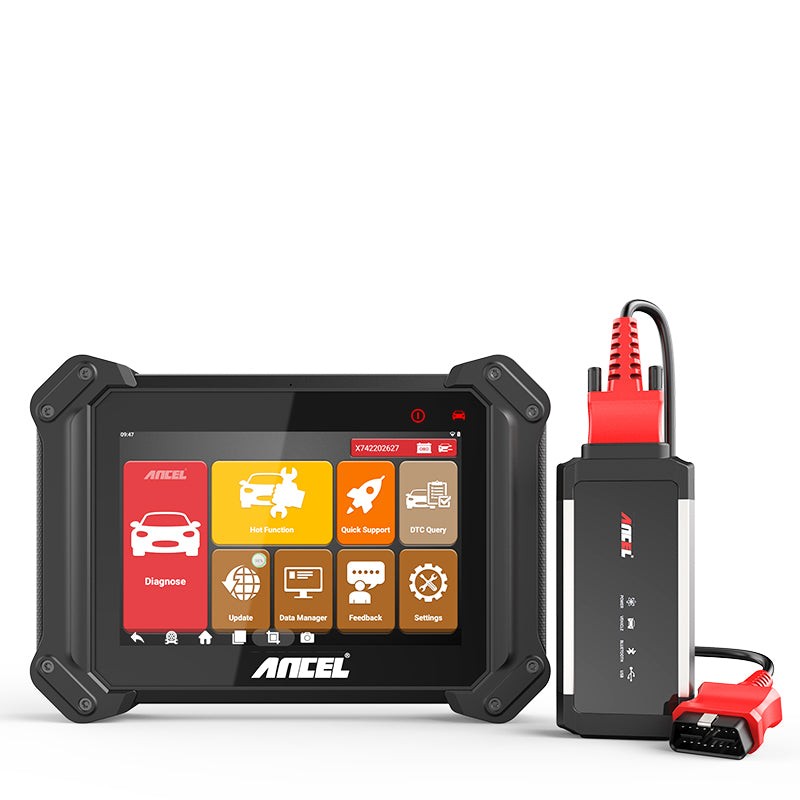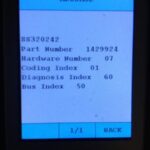Navigating the complexities of your vehicle’s health can be daunting, especially when the check engine light illuminates. Modern vehicles are equipped with sophisticated onboard diagnostic systems, and understanding the language they speak is crucial for effective car maintenance and repair. When you use an OBD2 scanner, you’ll encounter different types of diagnostic trouble codes (DTCs), and among them, stored codes are particularly significant.
But what exactly is an OBD2 stored code, and what does it mean for your vehicle? In this comprehensive guide, we’ll delve into the meaning of OBD2 stored codes, exploring their characteristics, why they matter, and how to effectively address them, ensuring your vehicle runs smoothly and efficiently.
What are OBD2 Stored Codes?
OBD2 stored codes are Diagnostic Trouble Codes (DTCs) that have been confirmed by your vehicle’s onboard diagnostic system (OBD) as representing persistent issues. Unlike pending codes, which are temporary and require further verification, stored codes indicate that a fault has been detected consistently over multiple monitoring cycles. This confirmation is what triggers the illumination of the check engine light, signaling that your vehicle needs attention.
Essentially, a stored code is your car’s way of saying, “Hey, there’s definitely something wrong here, and it’s not just a fleeting issue.”
Here’s a breakdown of the key characteristics of stored codes:
- Confirmed Issues: Stored codes represent faults that the OBD system has verified as persistent after multiple monitoring cycles. This means the issue isn’t just a one-time anomaly; it’s a recurring problem that needs to be addressed.
- Check Engine Light Activation: The most noticeable consequence of a stored code is that it typically triggers the check engine light on your dashboard. This light is a universal warning signal indicating that your vehicle’s computer has detected a problem that could affect emissions or performance.
- Persistence: Stored codes remain in your vehicle’s computer memory until they are manually cleared using an OBD2 scanner. Even after repairs are made, the code might need to be cleared to turn off the check engine light and reset the system monitors.
Examples of Common OBD2 Stored Codes
To better understand the practical implications of stored codes, let’s look at some common examples:
- Catalytic Converter Efficiency Below Threshold (P0420): This stored code indicates that the catalytic converter is not functioning as efficiently as it should. The catalytic converter is crucial for reducing harmful emissions, and this code often points to the need for inspection or replacement of the converter.
- Oxygen Sensor Circuit Slow Response (Bank 1, Sensor 2) (P0138): This stored code suggests that an oxygen sensor, which monitors the oxygen levels in your exhaust to ensure optimal fuel combustion, is responding slower than expected. This could indicate a faulty sensor or issues with its wiring.
- Fuel System Too Rich (Bank 1) (P0172): A stored code P0172 signifies that the engine’s fuel system is running too rich, meaning there’s too much fuel in the air-fuel mixture. This can lead to decreased fuel economy, poor engine performance, and potential damage if not addressed.
- Engine Misfire Detected (P0300 – P0308): Misfire codes, such as P0300 (Random/Multiple Cylinder Misfire) or P0301-P0308 (Cylinder Specific Misfire), are stored codes that indicate that one or more of the engine’s cylinders are not firing correctly. Misfires can be caused by various issues, including faulty spark plugs, ignition coils, or fuel injectors.
- EVAP System Leak Detected (P0440, P0455): Stored codes related to the Evaporative Emission Control System (EVAP) indicate leaks in the system that prevents fuel vapors from escaping into the atmosphere. These leaks can range from minor to major and affect emissions and fuel efficiency.
 Car Scanner | ANCEL
Car Scanner | ANCEL
Alt text: ANCEL V6 PRO+ Bluetooth Bidirectional Scan Tool displaying diagnostic information, highlighting its use for reading OBD2 stored codes.
Why Stored Codes Matter: The Check Engine Light’s Message
The check engine light, illuminated because of a stored code, is not something to ignore. It’s your vehicle’s warning system alerting you to potential problems that can impact:
- Emissions: Many stored codes relate directly to your vehicle’s emissions control systems. Ignoring these codes can lead to increased pollution and potentially failing emissions tests, which are required in many regions.
- Fuel Efficiency: Issues indicated by stored codes, such as a rich fuel condition or oxygen sensor problems, can negatively impact your fuel economy, costing you more money at the pump.
- Engine Performance: Stored codes can signal problems that affect engine performance, leading to reduced power, rough idling, or stalling.
- Potential Damage: Some stored codes, if left unaddressed, can lead to more severe and costly damage to your vehicle over time. For instance, a misfire can damage the catalytic converter, and a fuel system issue can harm the engine.
How to Deal with OBD2 Stored Codes
When your check engine light comes on and you suspect a stored code, here’s a systematic approach to dealing with it:
- Read the Codes with an OBD2 Scanner: The first step is to use an OBD2 scanner to read the stored codes. Tools like the ANCEL V6 PRO+ or other ANCEL OBD2 scanners are designed for this purpose. Connect the scanner to your vehicle’s OBD2 port (usually located under the dashboard) and follow the scanner’s instructions to retrieve the stored codes.
- Understand the Stored Code Meaning: Once you have the code, research its meaning. Online resources, repair manuals, and databases can help you understand what the code signifies and which vehicle systems it relates to. For example, a P0420 code indicates a catalytic converter issue.
- Diagnose the Underlying Problem: Simply knowing the stored code is not enough; you need to diagnose the root cause of the problem. For instance, a P0420 code might be caused by a faulty catalytic converter, but it could also be due to issues with oxygen sensors or exhaust leaks. Proper diagnosis may require further testing and inspection of the related components.
- Repair the Issue: After diagnosis, perform the necessary repairs. This could involve replacing faulty parts, fixing wiring issues, or addressing mechanical problems. It’s crucial to fix the underlying issue, not just clear the code, to prevent the problem from recurring and potentially causing further damage.
- Clear the Stored Code (After Repair): Once the repair is completed, use your OBD2 scanner to clear the stored code. Clearing the code turns off the check engine light. However, it’s important to only clear codes after you’ve addressed the underlying issue.
- Monitor and Test Drive: After clearing the code and making repairs, monitor your vehicle to ensure the check engine light does not reappear. Take your vehicle for a test drive under various driving conditions to confirm that the issue is resolved and that the system monitors reset correctly.
Stored Codes vs. Pending and Permanent Codes: A Quick Comparison
While stored codes indicate confirmed issues, it’s helpful to understand how they differ from other types of OBD2 codes:
- Pending Codes: These are preliminary codes that indicate a potential issue that the OBD system has detected but hasn’t yet confirmed as a persistent fault. Pending codes might not trigger the check engine light and can sometimes resolve themselves. If the issue persists, a pending code can escalate to a stored code.
- Permanent Codes: Permanent codes, on the other hand, are similar to stored codes in that they indicate confirmed issues. However, permanent codes cannot be cleared with a standard OBD2 scanner. They are designed to ensure that emission-related issues are properly repaired and verified before the code is reset automatically by the vehicle’s system after several successful driving cycles.
Understanding the distinction between these code types helps you prioritize and address vehicle issues effectively. Stored codes, with their confirmed status and check engine light activation, typically require more immediate attention than pending codes but are managed differently than permanent codes, which necessitate verified repairs for automatic clearing.
Clearing Stored Codes (and What Happens Next)
Clearing stored codes is a straightforward process using an OBD2 scanner. After connecting your scanner and navigating to the code clearing function, you can erase the stored codes from your vehicle’s computer memory.
However, it’s crucial to understand what happens after you clear a stored code:
- Check Engine Light Turns Off: Clearing the stored code will turn off the check engine light on your dashboard, provided there are no other active stored codes.
- System Monitors Reset: When you clear codes, you also reset the OBD system’s monitors. These monitors are diagnostic routines that the vehicle runs to check the functionality of various systems, such as the emission control system, fuel system, and oxygen sensors.
- Driving Cycles Required: After clearing codes, your vehicle needs to complete one or more “driving cycles” for the system monitors to run and confirm that all systems are functioning correctly. A driving cycle typically involves a combination of driving conditions, including cold starts, highway driving, and city driving.
- Code May Return if Issue Persists: If you clear a stored code without addressing the underlying problem, the check engine light and the stored code are likely to return after a few driving cycles once the OBD system re-detects the fault.
Therefore, clearing stored codes should always be done after diagnosing and repairing the underlying issue. It’s not a fix itself but a step in the process of verifying that the repair was successful and resetting the system.
Conclusion
OBD2 stored codes are a vital part of your vehicle’s self-diagnostic system. They provide valuable insights into your car’s health, signaling confirmed issues that require attention. Understanding the meaning of stored codes, how they differ from pending and permanent codes, and how to address them is essential for every vehicle owner.
By using an OBD2 scanner to read and clear stored codes and by taking a proactive approach to diagnosing and repairing the underlying issues, you can ensure your vehicle operates efficiently, reduces emissions, and stays in optimal condition for years to come. Consider exploring ANCEL’s range of OBD2 scanners to empower yourself with the tools needed for effective vehicle diagnostics and maintenance.
FAQs
Can I drive my car with a stored code and check engine light on?
While it might be tempting to ignore a check engine light, it’s generally not advisable to drive for extended periods with a stored code. Some issues indicated by stored codes can worsen over time or lead to more significant damage. It’s best to diagnose and address the problem as soon as possible. In some cases, the issue might be minor, but in others, it could indicate a problem that affects safety or could cause serious damage if ignored.
Will a stored code cause my car to fail an emissions test?
Yes, stored codes, especially those related to emissions control systems, can cause your vehicle to fail an emissions test. Emissions testing centers typically check for the presence of stored codes and ensure that all emission-related systems are functioning correctly. Addressing stored codes related to emissions is crucial for passing these tests.
How do I know if a stored code is serious?
The severity of a stored code depends on the specific code and the system it relates to. Some stored codes might indicate minor issues, while others can point to serious problems affecting safety or engine health. It’s best to research the specific code and consult with a mechanic if you are unsure about its severity. Generally, any stored code that triggers the check engine light warrants investigation and attention.
Can disconnecting the battery clear stored codes?
Yes, disconnecting the vehicle’s negative battery terminal for a period can clear stored codes in some vehicles. However, this method is not always reliable and is generally not recommended. Modern vehicles often retain codes even after battery disconnection. Furthermore, disconnecting the battery can reset other vehicle systems and settings. Using an OBD2 scanner to clear codes is a more effective and controlled method.
